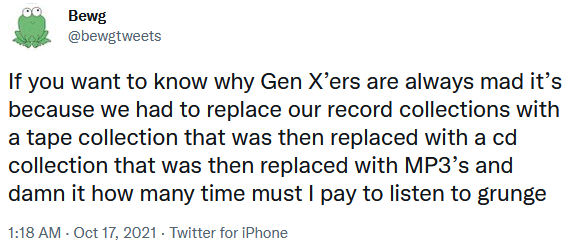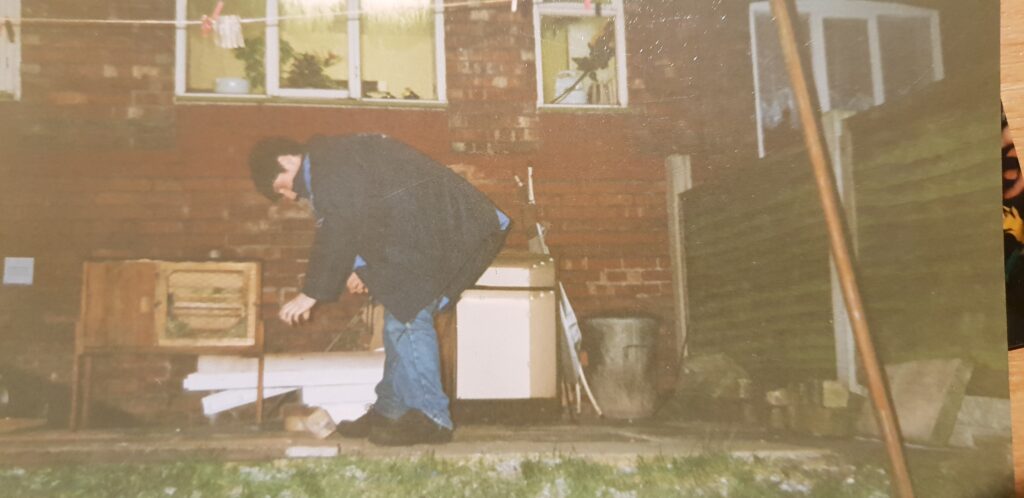Somebody shared with me a tweet about the tragedy of being a Gen X’er and having to buy all your music again and again as formats evolve. Somebody else shared with me Kyla La Grange‘s cover of a particular song .Together… these reminded me that I’ve never told you the story of my first MP3…1

In the Summer of 1995 I bought the CD single of the (still excellent!) Set You Free by N-Trance.2 I’d heard about this new-fangled “MP3” audio format, so soon afterwards I decided to rip a copy of the song to my PC.
I was using a 66MHz 486SX CPU, and without an embedded FPU I didn’t
quite have the spare processing power to rip-and-encode in a single pass.3
So instead I first ripped to an uncompressed PCM .wav file and then performed the encoding: the former step
was done almost in real-time (I listened to the track as it ripped!), about 7 minutes. The latter step took about 20 minutes.
So… about half an hour in total, to rip a single song.

Creating a (what would now be considered an apalling) 32kHz mono-channel file, this meant that I briefly stored both a 27MB wave file and the final ~4MB MP3 file. 31MB might not sound huge, but I only had a total of 145MB of hard drive space at the time, so 31MB consumed over a fifth of my entire fixed storage! Even after deleting the intermediary wave file I was left with a single song consuming around 3% of my space, which is mind-boggling to think about in hindsight.
But it felt like magic. I called my friend Gary to tell him about it. “This is going to be massive!” I said. At the time, I meant for techy people: I could imagine a future in which, with more hard drive space, I’d keep all my music this way… or else bundle entire artists onto writable CDs in this new format, making albums obsolete. I never considered that over the coming decade or so the format would enter the public consciousness, let alone that it’d take off like it did.

The MP3 file I produced had a fault. Most of the way through the encoding process, I got bored and ran another program, and this must’ve interfered with the stream because there was an audible “blip” noise about 30 seconds from the end of the track. You’d have to be listening carefully to hear it, or else know what you were looking for, but it was there. I didn’t want to go through the whole process again, so I left it.
But that artefact uniquely identified that copy of what was, in the end, a popular song to have in your digital music collection. As the years went by and I traded MP3 files in bulk at LAN parties or on CD-Rs or, on at least one ocassion, on an Iomega Zip disk (remember those?), I’d ocassionally see
N-Trance - (Only Love Can) Set You Free.mp34 being passed around and play it, to see if it was “my”
copy.
Sometimes the ID3 tags had been changed because for example the previous owner had decided it deserved to be considered Genre: Dance instead of Genre: Trance5. But I could still identify that file because
of the audio fingerprint, distinct to the first MP3 I ever created.
I still had that file when I went to university (where it occupied a smaller proportion of my hard drive space) and hearing that distinctive “blip” would remind me about the ordeal that was involved in its creation. I don’t have it any more, but perhaps somebody else still does.
Footnotes
1 I might never have told this story on my blog, but eagle-eyed readers may remember that I’ve certainly hinted at it before now.
2 Rewatching that music video, I’m struck by a recollection of how crazy popular crossfades were on 1990s dance music videos. More than just a transition, I’m pretty sure that most of the frames of that video are mid-crossfade: it feels like I’m watching Kelly Llorenna hanging out of a sunroof but I accidentally left one of my eyeballs in a smoky nightclub and can still see out of it as well.
3 I initially tried to convert directly from red book format to an MP3 file, but the encoding process was too slow and the CD drive’s buffer filled up and didn’t get drained by the processor, which was still presumably bogged down with framing or fourier-transforming earlier parts of the track. The CD drive reasonably assumed that it wasn’t actually being used and spun-down the drive motor, and this caused it to lose its place in the track, killing the whole process and leaving me with about a 40 second recording.
4 Yes, that filename isn’t quite the correct title. I was wrong.
5 No, it’s clearly trance. They were wrong.
I remember the ‘static’ on my copy of “I Would Rather Go Blind” as well. If we’ve spoken about this before, then did you also have a blip on Shakespeare’s Sister’s Stay?
Oh my gawd Matt you’re right, That blip, though, was very early on in the track and resulted from me having a loopback audio cable installed that I’d forgotten to remove before encoding the MP3, and was something like a notification sound from the operating system! I’d completely forgotten that before now: thanks!
I just tried relistening 5o the YouTube video and that is a prodigious amount of auto-tune